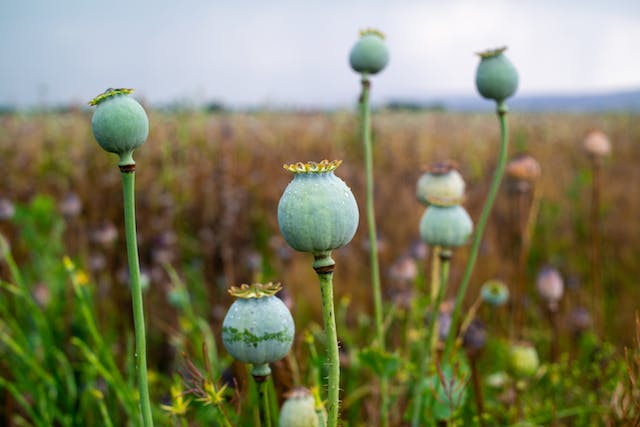
Why do poppies make opium? Not all poppies do make opium, but the ones that do, make it to ward off pests.
There are 775 different species of poppy, known as the Papaveraceae family. Most of them produce the milky latex that becomes opium in the opium poppy, but only the papaver somniferum is able to make opium. For this reason, it is commonly known as the opium poppy.
Opium is made from the dried latex that comes out of the seed capsules in the opium poppy. When the seed pods are ready, the opium farmers make shallow cuts in them with a special knife. They don’t cut too deeply because they don’t want to damage the seed pod. The poppy thinks that it is under attack from some kind of insect and releases latex to seal the wound and to kill any insects that would be dumb enough to try and eat it. The opium farmer leaves the cut seed pod overnight and the latex hardens. They can collect it in the morning and cut the pod again. The collected latex is put in a box to harden further, and then rolled into a ball to be sold. One acre of poppies can produce between three and five kilograms of opium.
Opium poppies produce opium as a deterrent to insects and animals. The opium is produced by the plant and released in the latex if any part of the plant is injured. It is strong enough to kill most insects and to deter all large animals from eating it. However, there are a few types of insects that are immune to it. This same situation arises with all plants that produce toxins. There are hundreds of plants that produce toxin to deter or kill insects and pests. And, just like the opium poppy, there is a pest that has evolved an immunity to those specific toxins. Hemlock is a good example. It is very poisonous and can be fatal if we eat it. Despite this, a small aphid called the woolly adelgid can eat hemlock very happily.
Opium and most of the other toxins in plants are made of alkaloids. An alkaloid is “an organic compound that can have physiological effects on humans”. There are over 3,000 different types of natural alkaloids made by plants. The ones contained in opium are morphine, codeine, and thebaine. Morphine and codeine are obviously isolated out of the opium to make morphine and any medicines containing codeine. These alkaloids affect us because they can attach themselves to receptors in our brains. Different alkaloids have different effects. Nicotine is an alkaloid, for example. When opium reaches the brain, the alkaloids bind to opium receptors and they reduce pain signals that are sent to the brain. They also activate the reward systems and increase the production of endorphins and dopamine. That makes opium extremely beneficial as pain relief medication, but it also makes it highly addictive.
Poppies have been cultivated since about 5000 BC. They were used for food and painkillers. It was cultivated in Mesopotamia from 3400 BC and was known as Hul Gil, which means the joy plant. Cultivation spread and opium became more popular. The emerging Silk Road helped spread it and increase trade in opium. These days there are two uses for the opium poppies that are grown. The first use is for medicine and the pharmaceutical industry. Most of this opium is produced in India, Turkey, Spain, and Australia and about 2,000 tons of it are produced a year. All of this goes into making the drugs we use, such as painkillers and other medication. This industry is legal and very heavily regulated.
The second use for opium is the drug trade. This industry is illegal and controlled by crime syndicates, cartels, and corrupt governments. The largest producer of illegal opium is Afghanistan, followed by Myanmar, and Mexico. Afghanistan produces about 7,000 tons of illegal opium a year, which is about 70% of all the opium produced in the world. The production is controlled by the Taliban, who take a 10% tax from the farmers. Most of the opium is converted into heroin and sold around the world. The tax and the sale of the drugs brings about $400 million a year to the Taliban. It is easy to criticize, but opium production has brought jobs to over 120,000 people in Afghanistan that wouldn’t necessarily be in work without it. And this is what I learned today.
Photo by hasan kurt: https://www.pexels.com/photo/poppy-plant-in-close-up-photography-11192482/
Sources
https://www.bbc.com/news/world-asia-58308494
https://www.mucd.org.mx/wp-content/uploads/2020/07/Opium-Briefing-ENGLISH-2019-WEB.pdf
https://letstalkscience.ca/educational-resources/stem-explained/how-do-alkaloids-cause-addiction
https://www.maine.gov/dacf/mfs/forest_health/insects/hemlock_woolly_adelgid_fact_sheet.htm
https://www.medicalnewstoday.com/articles/opioid-effects-on-the-brain#effects-on-the-brain
https://my.clevelandclinic.org/health/diseases/24122-poison-hemlock
https://www.insidescience.org/news/unraveling-genetic-mysteries-opium-poppy
